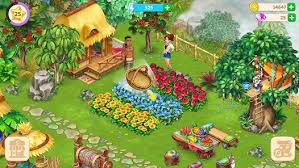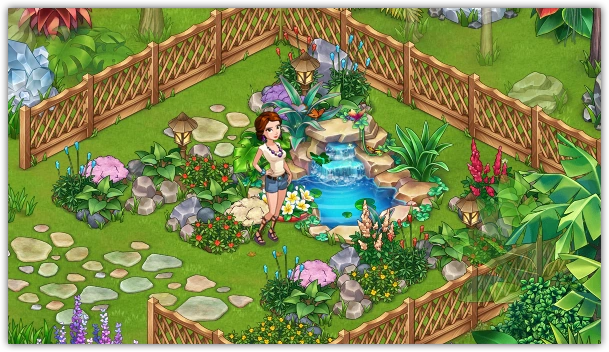
Taonga: Island Farm
| Genre: Simulation |
| Rating: |
Taonga: Island Farm Review — A Cozy Tropical Escape or Just Another Farm Sim?
There’s something oddly comforting about farming games, right? Maybe it’s the sense of control in a chaotic world, or the simple satisfaction of planting something and watching it grow—digitally, of course. But Taonga: Island Farm? It’s not just another farm sim with a palm tree slapped on top. It’s got that sunny, vacation-island charm mixed with a healthy dose of exploration and story progression that might just catch you off guard.
Let’s unpack that. And maybe—just maybe—you’ll find yourself getting a little too attached to your island neighbors and their oddly specific delivery requests.


So What’s the Vibe?
At first glance, Taonga: Island Farm feels like the usual: you’re dropped on a deserted island with a couple of tools and a handful of tutorials. But then it shifts. This isn't just about growing crops and decorating your land with suspiciously perfect hedges. It's got quests, side characters, ancient ruins, sea voyages—yes, actual boat trips—and just enough mystery to keep your mouse hovering for “one more task.”
You’re not just farming. You're building a life. And not in the overly existential Sims-style way, but in that casual, hey-I-just-harvested-coconuts-and-now-I’m-trading-them-for-shells kind of way.
Let’s Talk Gameplay – Simple on the Surface, Satisfying Beneath
Here’s the thing: Taonga keeps it light. You won’t be drowning in spreadsheets or micromanaging every square foot. It’s more intuitive than that. You click to plant, harvest, craft, and explore. No steep learning curve. No wiki rabbit hole.
But that doesn’t mean it’s mindless.
There’s a subtle rhythm to it. You’ll find yourself slipping into a gameplay loop that’s strangely therapeutic—chop a tree, feed a chicken, fix a dock, deliver gifts to an islander who somehow lost their fishing net… again. It’s not hard, but it is engaging. There's a soft logic that runs underneath every task—part resource management, part logistics puzzle. Like casually running a tiny island startup.
Tasks are timed, but not in that frustrating “wait 12 hours or else” kind of way. They feel manageable. And if you’re the type who likes lists, Taonga’s quest system scratches that “check-it-off” itch like a charm.
Characters That Grow on You (Like Kudzu)
You start out alone, but soon enough your island’s buzzing with all kinds of folks—each with their own quirks, catchphrases, and apparently unlimited enthusiasm for asking favors.
There’s Kauri, the island elder who seems to know everything but says very little. Then there’s Jesse, the energetic supply guy who somehow always shows up at just the right moment. And don’t get me started on Moana—her sass and side-eye game is strong.
At first, the character interactions feel scripted. But then—out of nowhere—a line hits differently. A comment feels warm. A small gesture from an NPC actually makes you pause. It’s subtle, but it’s there. The game layers in personality through repetition, tone, and slow character development. It’s the kind of storytelling that sneaks up on you. Before you know it, you’re genuinely curious about what happens next.
And sure, it’s no Mass Effect, but you’re not playing Taonga for world-ending stakes. You’re here for hammock-level chill, and the game delivers.
The Visuals – Yes, It’s That Pretty
Okay, let’s not pretend this doesn’t matter. Because Taonga? It’s easy on the eyes. The art is vibrant without being over-saturated. Think more Moana than Fortnite. It leans into those lush greens, sparkling blues, and golden sands in a way that makes you want to plan an actual island vacation.
Animations are smooth, transitions are clean, and the UI? Surprisingly tidy. No cluttered icons or eye-straining overlays. It’s clear someone cared about the layout—and your eyeballs will thank them.
There’s also a lot of little details tucked in. Chickens that peck and wander. Trees that gently sway. Campfires that flicker softly at dusk. It adds texture, and not just visually—it enhances the whole mood.
Honestly, if ambient island soundtracks and slow breezes are your thing, you might find yourself just sitting in-game doing nothing. No judgment here.
What About Progression? Is It All Coconut Trees and Sunshine?
That’s the clever part. Taonga isn’t static. Your island evolves—not just in size or decoration, but in complexity. Early on, it’s just crops and crates. Later? You’re building processing stations, upgrading your boat, managing trade routes, and exploring chain islands with names you’ll start to recognize like they’re part of your digital neighborhood.
The game introduces new mechanics slowly, which helps keep things fresh without overwhelming you. New zones, new characters, new crafting recipes—it trickles in at a nice pace.
And exploration? That’s where it gets interesting.
You’re not just expanding your own turf—you’re sailing out to help other communities, discover old ruins, solve tiny puzzles, and uncover backstories. It adds a little spice to the otherwise mellow stew. Think of it like adding chili flakes to your mango smoothie—it shouldn’t work, but it does.
The Sound Design – Surprisingly... Subtle?
Let’s be real. A lot of casual games phone this part in. Loop one generic track and call it a day. But Taonga actually puts in a bit of effort. The music is ambient, not pushy. A calm mix of soft percussion, gentle strings, and the occasional tropical twist. It’s music that fades into the background, not in a forgettable way, but in a "this-is-soothing-I-didn’t-even-notice-I’ve-been-playing-for-an-hour" way.
Sound effects are soft, too. Nothing jarring. Just a satisfying “clink” when you gather materials, the rustle of leaves, or the low hum of a campfire. It’s minimalism done right.
But... Is It All Just Escapism?
Kind of. And that’s not a bad thing.
We live in a world that’s constantly pinging us—emails, deadlines, responsibilities. Sometimes you just want a little virtual breathing room. A place to click some crops, fix a fishing net, and feel productive without breaking a sweat.
Taonga: Island Farm offers that. It doesn’t ask for too much. It doesn’t throw in chaos just for drama. It’s calm, even when you’re juggling five quests at once. There’s a rhythm, a kind of gentle productivity that feels... refreshing.
Is it groundbreaking? Not really. But it’s comforting, like a warm drink you didn’t know you needed.
The Little Things That Stick
Let’s circle back for a second—because part of what makes Taonga stick isn’t the mechanics or the visuals (though those help). It’s the tone. The way it balances familiarity and curiosity. You know the basics—grow crops, help villagers, expand territory. But then it throws in a ghost story. Or an ancient relic. Or a character with a surprisingly heartfelt monologue.
It’s these small narrative jolts that keep the game from fading into the pile of other island sims. It invites a kind of lingering.
And those tiny rituals—like checking your workshop in the morning or swinging by the pier before logging off—they start to feel cozy. Almost real.
Okay, But Who’s It Really For?
Great question. Taonga probably won’t thrill adrenaline junkies or hardcore strategy purists. But if you like games that reward steady pacing, offer a little story, and look darn pretty while doing it—you’ll be right at home.
It's ideal for:
-
Folks who need a chill, low-pressure game to unwind
-
Fans of titles like Farmville, Stardew Valley, or Animal Crossing (but with a more tropical flair)
-
Players who enjoy quest-based progression and mild exploration
-
Anyone who secretly likes organizing things and making lists
Also? It’s perfect for dipping in and out. You can play for ten minutes or an hour and still feel like you accomplished something.
Final Thoughts – A Sunny Spot in a Noisy World
Here’s the kicker: Taonga: Island Farm isn’t trying to be the next big thing. It’s not trying to revolutionize gaming. And honestly? That’s what makes it so charming.
It leans into warmth. It embraces a slower pace. It gives you a space to be kind, productive, and just a little adventurous. In a world that often asks us to do too much, this game just asks you to plant some corn, build a pier, maybe help a neighbor—and smile while doing it.
And that’s kind of beautiful, isn’t it?